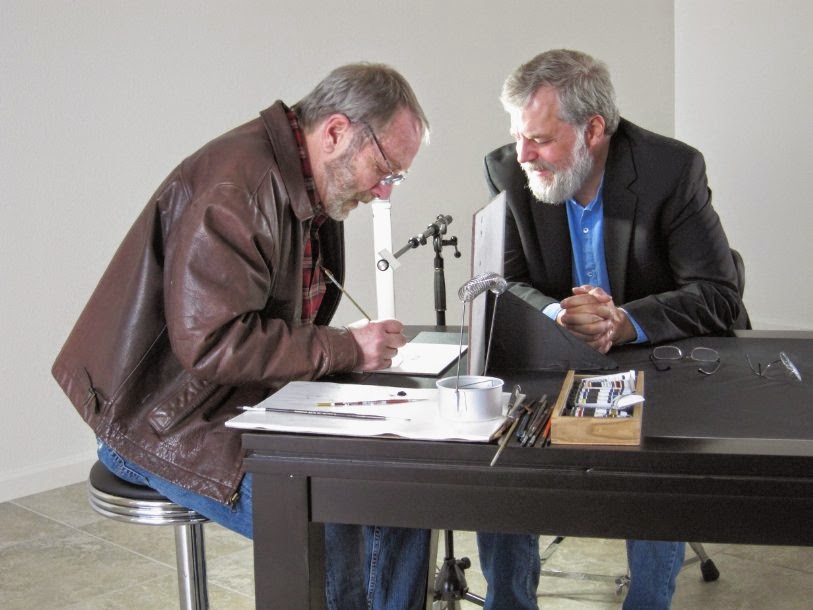Tim's Vermeer
Tim's Vermeer
(2015)
A Review by Grant Kanigan
Directed by: Raymond Teller
Written by: Raymond Teller, Penn JIllette
Starring: Tim Jenison, Penn Jillette,
Martin Mull
Rating: G
Release Date: February 21st, 2014
 |
| Martin Mull & Tim Jenison watch paint dry in Tim's Vermeer © 2013 - Sony Pictures Classics |
Tim's Vermeer follows the eponymous Tim Jenison, inventor, software designer and CEO of NewTek, a lucrative software company. Always busy and curious, the attention to detail and transcendent quality of dutch painter Johannes Vermeer has always been in the back of Jenison's mind. Vermeer, painter of such famous works as Girl With a Pearl Earring and The Music Lesson, has always been a pillar of the art world, for his seminal and brilliantly photorealistic paintings he completed during his lifetime, (1632-1675). Armed with his scientific reasoning and curious mind, Jenison creates a tool that allows him to create photorealistic works himself. By a series of mirrors, one of which reflects a picture above of a canvas, Jenison realizes he may have stumbled onto one of the tools Vermeer used to create his works of art. This raises a difficult question - if Vermeer was just duplicating real images, was he truly an artist? Or merely a smart man with the right tools?
To test his theory, Jenison decides to recreate Vermeer's massively complex Music Lesson, in full scale. To do so, Jenison decides to only use the tools that Vermeer would have had access to during his lifetime. Using natural light, hand crafted tools, instruments as well as paint, and a still set replicating the Music Lesson, Jenison begins the long, arduous process of creating his very own Vermeer.
There are a few criticisms of Jenison's experiment. Vermeer may not have used the tools showcased in Penn and Teller's film, or that Jenison is nothing but a curious mimic with too much time on his hands. Nonwithstanding the damning evidence that Jenison puts forward in favour of his theory of Vermeer's tools, Tim's Vermeer is as much about Tim as it is Vermeer. We see Tim question his devotion, what it means to duplicate art, and if spending his time on such a laborious project is really worth his time. The film boils down an interesting discussion of art; in a world where, "nothing means anything" which is a nihilistic, yet realistic approach, is not art the only hope humanity has in creating something representative of ourselves that outlasts our lifetimes? Art is a concrete artifact of our existence - proof we were really here. Tim's Vermeer argues that any art is valid, as long as it holds meaning, and leaves the audience with the revelation that art is a collective refusal to vanish from life back into the void of death, without making some noise:
There are a few criticisms of Jenison's experiment. Vermeer may not have used the tools showcased in Penn and Teller's film, or that Jenison is nothing but a curious mimic with too much time on his hands. Nonwithstanding the damning evidence that Jenison puts forward in favour of his theory of Vermeer's tools, Tim's Vermeer is as much about Tim as it is Vermeer. We see Tim question his devotion, what it means to duplicate art, and if spending his time on such a laborious project is really worth his time. The film boils down an interesting discussion of art; in a world where, "nothing means anything" which is a nihilistic, yet realistic approach, is not art the only hope humanity has in creating something representative of ourselves that outlasts our lifetimes? Art is a concrete artifact of our existence - proof we were really here. Tim's Vermeer argues that any art is valid, as long as it holds meaning, and leaves the audience with the revelation that art is a collective refusal to vanish from life back into the void of death, without making some noise:
"Do not go gentle into that good night,
Old age should burn and rave at close of day;
Rage, rage against the dying of the light.
Though wise men at their end know dark is right,
Because their words had forked no lightning they
Do not go gentle into that good night.
Good men, the last wave by, crying how bright
Their frail deeds might have danced in a green bay,
Rage, rage against the dying of the light.
Wild men who caught and sang the sun in flight,
And learn, too late, they grieved it on its way,
Do not go gentle into that good night.
Grave men, near death, who see with blinding sight
Blind eyes could blaze like meteors and be gay,
Rage, rage against the dying of the light.
And you, my father, there on the sad height,
Curse, bless, me now with your fierce tears, I pray.
Do not go gentle into that good night.
Rage, rage against the dying of the light."
Grant's Rating: 5/5 Stars
Martin Mull and Tim Jenison in Tim's Vermeer: "Martin Visits"



Comments